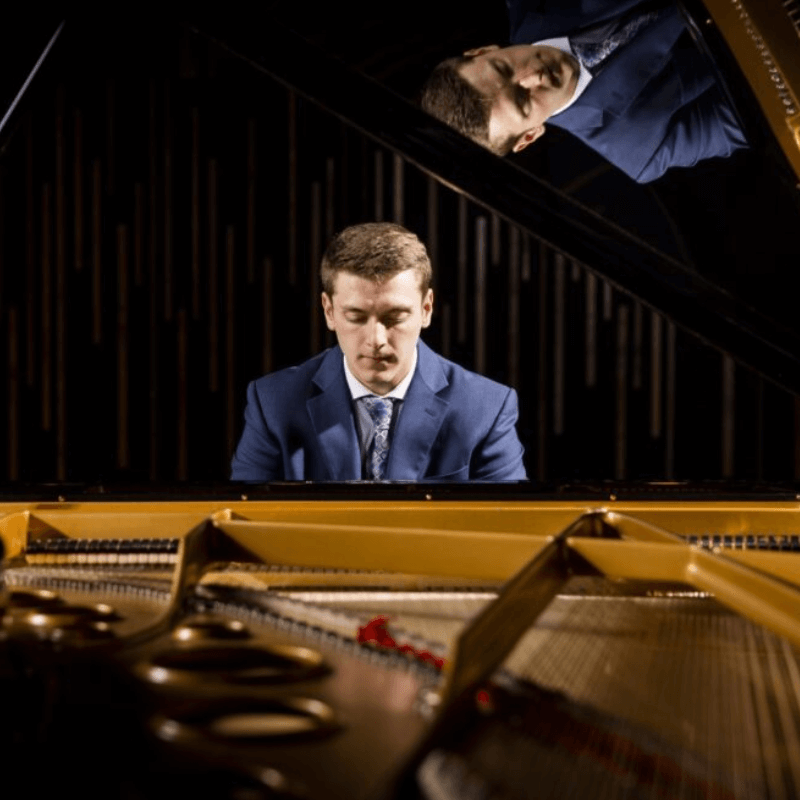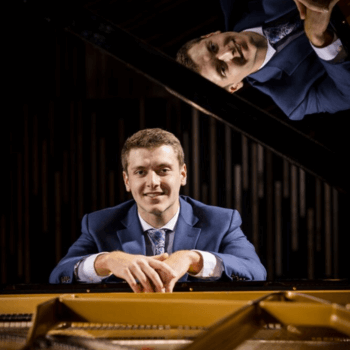Events

Classic Series
RHAPSODY & ROMANCE
Saturday
Jan 25, 2025
7:30PM
Alberta Bair Theater
2801 3rd Ave N
$20-74
Tanner Jorden, Piano
Anna Clyne | Masquerade
Sergei Prokofiev | Suite from Romeo & Juliet
Sergei Rachmaninoff | Rhapsody on a Theme of Paganini
A glittering Masquerade sets the stage for a night of musical romance … and the return of Billings’ own Tanner Jorden. After this rising star pianist’s mesmerizing performance of Rachmaninoff’s Rhapsody on a Theme of Paganini, lose yourself in the emotionally charged music of Prokofiev’s Romeo & Juliet.
Doors open: 6:30PM
Pre-Concert Cues: 6:40PM
Call 406-256-6052 to order tickets or 406-252-3610 for more information
- The idea of creating a ballet of Romeo and Juliet came from the Soviet stage director Sergei Radlov (1892-1958), an important figure in the Russian theatrical avant-garde both before and after the 1917 Revolution. The stage premiere of the full-length ballet eventually took place not in Russia, but in Brno, Czechoslovakia, with choreography by Ivo Psota, who also danced the role of Romeo. The first Russian production at the Kirov Theatre in Leningrad was choreographed by Leonid Lavrovsky. Galina Ulanova scored one of her greatest successes in the role of Juliet.
- Niccolò Paganini was the closest thing the 18th century had to a rock star. He was known throughout Europe for his technical prowess as well as the works he composed to show off his unmatched skills on the violin.
- London-born Anna Clyne is a Grammy-nominated composer of acoustic and electro-acoustic music. Clyne has boldly charted her own course and was heralded in a New York Times profile as a “composer of uncommon gifts and unusual methods.”
ABOUT THE PROGRAM
ANNA CLYNE (b. 1980)
Masquerade
From the composer: “Masquerade draws inspiration from the original mid-18th century promenade concerts held in London’s pleasure gardens. As is true today, these concerts were a place where people from all walks of life mingled to enjoy a wide array of music. Other forms of entertainment ranged from the sedate to the salacious with acrobatics, exotic street entertainers, dancers, fireworks and masquerades. I am fascinated by the historic and sociological courtship between music and dance. Combined with costumes, masked guises and elaborate settings, masquerades created an exciting, yet controlled, sense of occasion and celebration. It is this that I wish to evoke in Masquerade.
“The work derives its material from two melodies. For the main theme, I imagined a chorus welcoming the audience and inviting them into their imaginary world. The second theme, Juice of Barley, is an old English country dance melody and drinking song, which first appeared in John Playford’s 1695 edition of The English Dancing Master.”
SERGEI RACHMANINOFF (1873–1943)
Rhapsody on a Theme of Paganini
It seems appropriate that this great piano composer-virtuoso paid tribute to the great violin composer-vituoso Niccolo Paganini. In 1820 Paganini published a set of twenty-four Caprices for unaccompanied violin. Like Chopin’s Études, these were more than mere technical exercises. Their musical merit was sufficient to inspire such composers as Schumann, Liszt, and Brahms to use them as the basis for piano compositions. The twenty-fourth Caprice in A minor, with its theme-and-variations form, has been a particularly fertile source of inspiration for subsequent composers. Rachmaninoff wrote his set of variations for piano and orchestra in 1934.
The Rhapsody consists of a brief introduction, the theme, and twenty-four variations. It is somewhat unusual in that the first variation—a skeletal outline of the theme—appears before the statement of the theme itself. Although the Paganini theme serves as the thematic foundation, a subsidiary melody, the plainchant Dies irae (“Day of Wrath”) is also featured at times. This evocation of fire and brimstone appears most obviously in the seventh, tenth, and twenty-fourth variations. The variations go through many moods and styles—march, waltz, scherzo—culminating in the lush romanticism of the familiar eighteenth variation, derived from melodic inversion of Paganini’s theme (that is, rising steps are transformed into equivalent falling steps and vice versa). This lyrical variation has been used in various movie and television soundtracks, including the films, Somewhere in Time (1980) and Groundhog Day (1993). The success of a 1939 adaptation as a ballet, based very freely on the life of Paganini, so pleased Rachmaninoff that he wrote his Symphonic Dances in 1940 with choreographer Michel Fokine in mind. He played the piano version for Fokine, but both died before the idea got any further.
This is the BSO’s sixth performance of this work. Previous soloists were Allen Kindt (1973), Olivier Sorensen (1986), Lorin Hollander (1992), Andrew von Oeyen (2014), and Gabriela Martinez (2021).
New to this piece? Although the variations are performed in one stretch without breaks, they can be divided into three sections—each corresponding to the traditional three movements of a concerto. Think of the beginning through Variation 10 as the first movement, Variations 11 to 18 as the equivalent of a slow movement, and the remaining variations as a spirited finale.[2]
SERGE PROKOFIEV (1891–1953)
Select movements from Romeo & Juliet
Prokofiev composed this ballet in 1935 for the Bolshoi Ballet of Moscow. The ballet company claimed that it was not danceable and refused to produce it. Instead, the work was first performed in 1938 at Brno, Czechoslovakia. The first Russion performance took place in St. Petersburg in 1940. It soon entered the repertoire as one of the most important and best-loved modern ballets, and even the Bolshoi eventually reversed its earlier judgment.
While waiting for the ballet to be produced, Prokofiev arranged two orchestral suites and a collection of piano pieces from the score. He also composed a third orchestral suite in 1946. The suites seem designed to arouse interest in the ballet, especially since listeners were assumed to be familiar with the plot from the Shakespearean play. Prokofiev performed the suites during what would be his last tours in the West: the First Suite in Paris and Chicago (in December 1936 and January 1937, respectively), and the Second in Boston in March 1938.
The numbers selected for this performance begin with an ominous picture of the feuding families followed by the swaggering nobility at the Capulets’ ball. In Masks, Romeo and his friends disguise themselves and crash the Capulets’ party. For the Departure of the Guests, Prokofiev recycled the Gavotte from his youthful Classical Symphony. The movement title Romeo and Juliet accompanies Shakespeare’s famous balcony scene. Another clash between the warring clans leads to a duel in which Romeo kills Tybalt and the Capulets mourn him. The last movement brings the story to its emotionally wrenching conclusion.
The Billings Symphony’s (only) previous performance of movements from Prokofiev’s iconic score was in February 2008 for Tango & Romance, featuring Quartango and tango dancers Fabian Belmonte & Roxana Callegari.
GUEST artist
TANNER JORDEN | PIANO
Kindled by a profound connection with the piano literature early on, Tanner Jorden embarked on a journey towards true artistry driven by an intimate resonance with the life-like emotion present in music.
Shortly before leaving his home in Montana, Jorden received First Prize at the Sir Donald Runnicles Young Artist Competition, accompanied by a prestigious scholarship. He has also won top prizes in the William Knabe, American Protégé, and ArsClassica International competitions. Most recently, Jorden won Second Prize at the Music Teacher National Association (MTNA) Young Artist National Competition, being the youngest among finalists who were deep in their graduate degrees.
As a frequent soloist with professional orchestras, Jorden has a large repertoire featuring concertos by Rachmaninoff, Liszt, Grieg, Prokofiev, Mozart, Chopin, and more. Most recently he performed Mozart Concerto in C, K.467 with Sir Donald Runnicles and two weeks later traveled to Italy to perform the same work with the San Marino Orchestra and Hobart Earle. He has performed with other celebrated conductors such as Gordon Johnson, John Zoltek, and Anne Harrigan. In his Freshman year, he won the BYU Concerto Competition and performed Liszt Concerto in E-flat major with the school’s orchestra. Jorden will perform Prokofiev Concerto No. 3 in C with the Utah Valley Symphony as well as Rachmaninoff Rhapsody on a Theme of Paganini with the Billings Symphony in their upcoming seasons.
Jorden is currently a student of Scott Holden and a Junior in his Bachelor’s degree at Brigham Young University, and will be pursuing graduate studies in the near future. He has studied at festivals including PianoTexas, Miami International Piano Festival in Italy, Tel Hai Masterclasses in Israel, and Rebecca Penneys Piano Festival. He has had masterclasses with Vladimir Ovchinnikov, Antonio Pompa-Baldi, Douglas Humphreys, Tamás Ungár, Josu de Solaun, and Robert McDonald.
An avid mountain biker and outdoorsman, Jorden believes that time away from the instrument is best spent finding oneself in nature.







